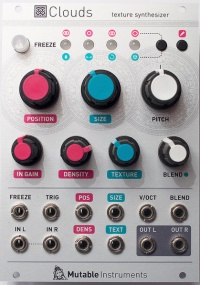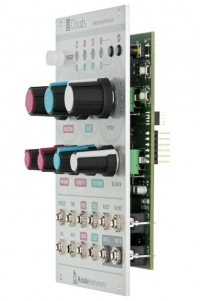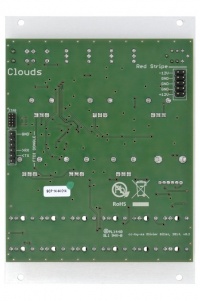Mutable Instruments Clouds
Texture synthesizer
Sommaire
Pitch-shifter/time-stretcher
This engine is quite similar to the granular mode, except that it uses two overlapping grains synchronized with the most salient period of the sound. The grains are carefully spliced so that they mesh well with each other (a technique similar to the “deglitching” of early pitch-shifters). Modulating POSITION when recording is frozen will “scrub” through the audio buffer. Clouds’ uses classic time-domain methods which are not suitable for polyphonic or percussive material (unless this percussive material is breakbeats and you liked Akai samplers. Then: smile).
DENSITY creates a granular diffusion effect based on all-pass filters; and TEXTURE acts as a low-pass/high-pass filter. SIZE controls the size of the overlapping windows used for pitch-shifting and time-stretching – from an extremely grainy “drilling” sound to smooth bits of loops.
Sending a trigger on the TRIG input creates a clock-synchronized loop (when FREEZE is enabled) or stuttering effect – equivalent to applying a tempo-synchronized decaying envelope on the POSITION parameter. Looping delay
Looping delay
The looping delay engine continuously plays back audio from the buffer without any kind of granularization. POSITION controls the distance between the playback head and the recording head (in other words, the delay time). Modulating POSITION will create effects similar to vinyl scratching or manual manipulation of tape. When FREEZE is activated, the content of the audio buffer is looped (stutter effect). POSITION controls the loop start and SIZE the loop duration.
DENSITY creates a granular diffusion effect based on all-pass filters; and TEXTURE acts as a low-pass/high-pass filter. SIZE controls the size of the overlapping windows used for pitch-shifting – fully clockwise for a smooth result that might smear transients, fully counterclockwise for a grainy, almost ring-modulated sound.
When FREEZE is enabled, sending a trigger on the TRIG input creates a clock-synchronized stuttering loop. Otherwise, the period of the trigger pulses sets the delay time – provided this delay is shorter than the recording buffer size.
Spectral Mode
Parameters in spectral mode:
POSITION = selects in which buffer the audio is poured (when FREEZE is not active), or from which buffer the audio is synthesised (when FREEZE is active).
Example:
Set POSITION to minimum value. FREEZE. You get a first texture. Set POSITION to maximum value. UNFREEZE. Wait for something else to happen in the incoming audio. FREEZE again. By moving POSITION you interpolate between the two textures which had been captured at the press of FREEZE. Depending on the quality settings there are 2 to 7 buffers laid out on the course of the POSITION knob. So it's a bit like morphing between FFT slices.
SIZE = change the coefficients of a polynomial that determines how frequencies are mapped between the analysis and synthesis buffers. It's like a 1-knob GRM Warp. Over the course of the knob it'll do spectral shifting, but also spectral reversal.
PITCH = pitch-shifting.
DENSITY determines how results from the analyzer are passed to the resynthesizer. Below 12 o'clock, there's some increasing probability that a given FFT bin won't get updated, causing a kind of partial freeze. After 12 o'clock, adjacent analysis frames are increasingly merged together (like a low-pass filter in the amplitude each frequency bin). At extreme settings, random phase modulation is applied to smooth things - giving you different flavours of spectral muddling/reverb.
TEXTURE does two things: below 12 o'clock, it increasingly quantize the amplitudes of the spectral components, like a very low-bitrate audio file (a long time ago I loved making super harsh noise textures by loading text files as raw audio files in an audio editor... then encoding as mp3 or real audio with super low bitrate to make it sound like some underwater brian eno). After 12 o'clock, it increasingly weakens the strongest partials and amplifies the weakest ones. This has the effect of making the spectrum more noise-like.
Clouds Cheatsheet
by ???
all the modes + parasites firmware modes
Clouds Illustrated manual
by ???
Fichier:Clouds Illustrated Manual.pdf
Supercrysalis_memo_for_MI_Clouds
by mercutio
Fichier:Supercrysalis memo for MI Clouds.pdf
Olivier's notes
As for Clouds, I don't even know where to start! As a module designer, it's very frustrating to see that it has become popular for all the wrong reasons. It seems to me that for a large number of people the trajectory is: "ohh I feed audio into it and it makes ambient-ish muddy sounds on the out. (later) I'm tired of the muddy sounds, let's install the alternative firmware and see if it can do more". The key to use this module is to feed random source into its CV inputs to randomize the grain parameters (otherwise all grains are the same and wow, you're stacking 40 delayed versions of the same audio signal... no wonder it's muddy). Any "granularizer" plug-in will have randomization built-in, but Clouds doesn't have any randomization built-in because hey, it's a module, you're supposed to make it happen with external modulations... Here's an example of interesting use of the module - creating chords from any oscillator. https://www.youtube.com/watch?v=gSdmQ08JUGM. Another completely different sort of game is to have gate/trigger patterns in the FREEZE and TRIG inputs for stuttering/glitch effects. Yet how many times I've seen Clouds without any other connections than IN L, OUT L and OUT R...
There's a lot of negative influence from the "VST culture" - people considering that one module = one virtual instrument or one module = one effect. I'm partly responsible because I tend to add to each of my modules the extra ingredient (an internal modulation, an internal VCA, an internal exciter...) that allows them to be played on their own in a small system. But they acquire all they value when they play a role within a larger patch...
liens
playlist sur youtube : https://www.youtube.com/embed/cy34cBwM-Uo?list=PL54NASqAHmsRHRedsHZtW2QLKNsgGpmhu
clouds/parasites reference guide : https://drive.google.com/file/d/0Bx2WGFW47ykbSXJRNEFwRHhBN1E/view
videos
https://www.youtube.com/watch?v=cy34cBwM-Uo&list=PL54NASqAHmsRHRedsHZtW2QLKNsgGpmhu


